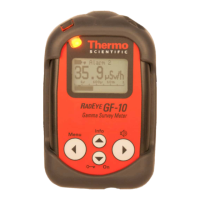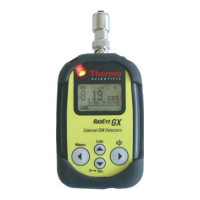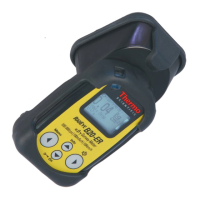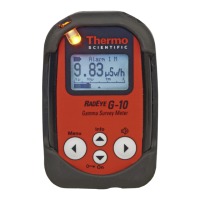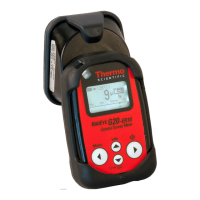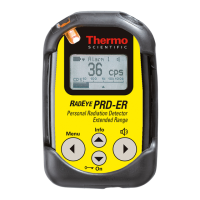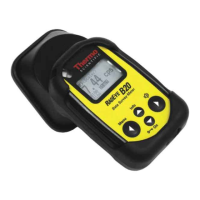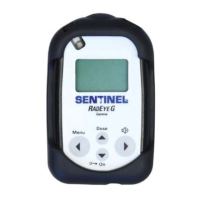Do you have a question about the Thermo Scientific RadEye AB100 and is the answer not in the manual?
Lists the items included in the RadEye AB100 package, including C cells and the operating manual.
Provides step-by-step instructions for inserting batteries into the RadEye AB100 unit.
Explains the procedure for powering on the RadEye AB100 instrument by pressing the ON button.
Describes how to navigate the operating menu, its structure, and key functions.
Explains the Ratemeter mode, including its standard display, trend indication, and Ratemeter Tau.
Details the Scaler mode operation, covering mean value and accumulated counts.
Covers the process of performing background measurements and setting parameters.
Explains how to set and configure alarm thresholds for count rate and activity.
Details how to set alarm thresholds using the relative standard deviation (sigma) method.
Describes the audible single pulse indication feature and how to enable/disable it.
Explains the different alarm indications (LED, sound, vibrator) when thresholds are exceeded.
Details how to lock the keypad to prevent unintended operations and save battery.
Explains manual and automatic methods for setting the high voltage of the instrument.
Information on using an optional earphone for alarming in noisy environments.
Describes how to configure alarm latching for storing alarms for a specified time.
How to view stored alarms in the alarm log with time information.
Explains how to store and display custom text information on the RadEye.
Details the different display modes available for measurement values.
How to subtract the alpha rate from the alpha-beta rate display.
Instructions for setting the instrument's date and time.
Selection of battery type for correct low battery warning functionality.
Describes how to manually log measurement values with record numbers.
Instructions for changing the language of the RadEye menu.
How to adjust the contrast of the LCD display.
Parameter for setting the time constant used in Ratemeter Tau mode.
Explains how to adjust the position of the display unit.
Explains general measurement units like counts per second (cps) and counts per minute (cpm).
Details units for surface contamination measurement, including Bq, dps, dpm, and Bq/cm2.
Describes how to perform a simple functional test of the instrument.
Explains the different failure messages displayed on the LCD and their meanings.
Describes the indication shown when the count rate exceeds the defined maximum level.
Details how to use a test adapter to verify the radiation response performance.
Explains the low battery warning indicators and behavior.
Details the serial and USB interface options for connecting the RadEye to a PC.
Instructions for starting the RadEye.EXE software and accessing device parameters.
Explains the status messages displayed during plateau measurements.
Details how to set parameters like start/end HV, step size, and preset time.
Procedure for initiating a plateau measurement and entering identification text.
Instructions on how to print the results of a plateau measurement.
Explains how measured plateau data is automatically saved to a monthly file.
How to open and review previously saved plateau measurement files.
Details on applying the entered high voltage value to the amplifier.
Configuration options for the Y-axis scaling in plateau measurement graphs.
Provides examples of beta and alpha plateau measurements.
Troubleshooting steps for when the instrument fails to power on.
Information displayed on the startup screen, including calibration and voltage.
Troubleshooting for missing menu items, checking firmware and settings.
Guidance on interpreting and resolving error messages displayed on the unit.
Steps to resolve issues where the RadEye is not recognized by the PC software.
Solutions for lost date and time settings, often related to battery removal.
Troubleshooting tips for incorrect battery status readings.
Addresses issues with incorrect time and date in historical data.
Detailed instructions for replacing the window foil on the detector.
List of available spare parts with their corresponding part numbers.
Information about the earphone accessory for noisy environments.
Details on the test adapter for verifying radiation response performance.
Description of the serial IR connection cable for PC connectivity.
Description of the USB IR connection cable for PC connectivity.
Lists the main technical specifications for the RadEye AB100 instrument.
Details the changes and features introduced in different firmware versions.
| Type | Personal Radiation Detector |
|---|---|
| Radiation Detected | Gamma and X-ray radiation |
| Detector Type | Energy-compensated GM tube |
| Operating Temperature | -20°C to +50°C |
| IP Rating | IP67 |
| Measurement Range | 0.01 µSv to 10 Sv |
| Energy Range | 60 keV to 1.5 MeV |
| Accuracy | ±15% |
| Display | LCD |
| Alarm | Audible and visual alarm |
